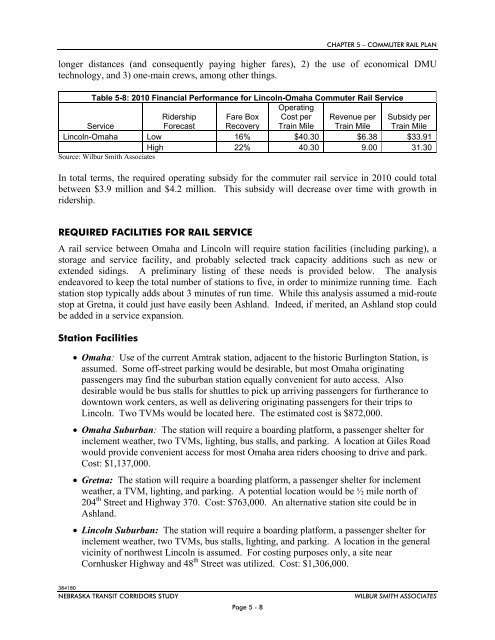NTRAC Final Study - Nebraska Department of Roads - State of ...
NTRAC Final Study - Nebraska Department of Roads - State of ...
NTRAC Final Study - Nebraska Department of Roads - State of ...
Create successful ePaper yourself
Turn your PDF publications into a flip-book with our unique Google optimized e-Paper software.
CHAPTER 5 – COMMUTER RAIL PLAN<br />
longer distances (and consequently paying higher fares), 2) the use <strong>of</strong> economical DMU<br />
technology, and 3) one-main crews, among other things.<br />
Table 5-8: 2010 Financial Performance for Lincoln-Omaha Commuter Rail Service<br />
Operating<br />
Service<br />
Ridership<br />
Forecast<br />
Fare Box<br />
Recovery<br />
Cost per<br />
Train Mile<br />
Revenue per<br />
Train Mile<br />
Subsidy per<br />
Train Mile<br />
Lincoln-Omaha Low 16% $40.30 $6.38 $33.91<br />
High 22% 40.30 9.00 31.30<br />
Source: Wilbur Smith Associates<br />
In total terms, the required operating subsidy for the commuter rail service in 2010 could total<br />
between $3.9 million and $4.2 million. This subsidy will decrease over time with growth in<br />
ridership.<br />
REQUIRED FACILITIES FOR RAIL SERVICE<br />
A rail service between Omaha and Lincoln will require station facilities (including parking), a<br />
storage and service facility, and probably selected track capacity additions such as new or<br />
extended sidings. A preliminary listing <strong>of</strong> these needs is provided below. The analysis<br />
endeavored to keep the total number <strong>of</strong> stations to five, in order to minimize running time. Each<br />
station stop typically adds about 3 minutes <strong>of</strong> run time. While this analysis assumed a mid-route<br />
stop at Gretna, it could just have easily been Ashland. Indeed, if merited, an Ashland stop could<br />
be added in a service expansion.<br />
Station Facilities<br />
Omaha: Use <strong>of</strong> the current Amtrak station, adjacent to the historic Burlington Station, is<br />
assumed. Some <strong>of</strong>f-street parking would be desirable, but most Omaha originating<br />
passengers may find the suburban station equally convenient for auto access. Also<br />
desirable would be bus stalls for shuttles to pick up arriving passengers for furtherance to<br />
downtown work centers, as well as delivering originating passengers for their trips to<br />
Lincoln. Two TVMs would be located here. The estimated cost is $872,000.<br />
Omaha Suburban: The station will require a boarding platform, a passenger shelter for<br />
inclement weather, two TVMs, lighting, bus stalls, and parking. A location at Giles Road<br />
would provide convenient access for most Omaha area riders choosing to drive and park.<br />
Cost: $1,137,000.<br />
Gretna: The station will require a boarding platform, a passenger shelter for inclement<br />
weather, a TVM, lighting, and parking. A potential location would be ½ mile north <strong>of</strong><br />
204 th Street and Highway 370. Cost: $763,000. An alternative station site could be in<br />
Ashland.<br />
Lincoln Suburban: The station will require a boarding platform, a passenger shelter for<br />
inclement weather, two TVMs, bus stalls, lighting, and parking. A location in the general<br />
vicinity <strong>of</strong> northwest Lincoln is assumed. For costing purposes only, a site near<br />
Cornhusker Highway and 48 th Street was utilized. Cost: $1,306,000.<br />
384180<br />
NEBRASKA TRANSIT CORRIDORS STUDY<br />
Page 5 - 8<br />
WILBUR SMITH ASSOCIATES

















